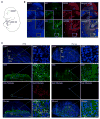Derivation of Pluripotent Stem Cells with In Vivo Embryonic and Extraembryonic Potency
- PMID: 28388409
- PMCID: PMC5679268
- DOI: 10.1016/j.cell.2017.02.005
Derivation of Pluripotent Stem Cells with In Vivo Embryonic and Extraembryonic Potency
Abstract
Of all known cultured stem cell types, pluripotent stem cells (PSCs) sit atop the landscape of developmental potency and are characterized by their ability to generate all cell types of an adult organism. However, PSCs show limited contribution to the extraembryonic placental tissues in vivo. Here, we show that a chemical cocktail enables the derivation of stem cells with unique functional and molecular features from mice and humans, designated as extended pluripotent stem (EPS) cells, which are capable of chimerizing both embryonic and extraembryonic tissues. Notably, a single mouse EPS cell shows widespread chimeric contribution to both embryonic and extraembryonic lineages in vivo and permits generating single-EPS-cell-derived mice by tetraploid complementation. Furthermore, human EPS cells exhibit interspecies chimeric competency in mouse conceptuses. Our findings constitute a first step toward capturing pluripotent stem cells with extraembryonic developmental potentials in culture and open new avenues for basic and translational research. VIDEO ABSTRACT.
Keywords: chimeric ability; embryonic and extraembryonic developmental potentials; interspecies chimeric competency; single-cell derived chimeras.
Copyright © 2017 Elsevier Inc. All rights reserved.
Figures







References
-
- Abad M, Mosteiro L, Pantoja C, Cañamero M, Rayon T, Ors I, Graña O, Megías D, Domínguez O, Martínez D, et al. Reprogramming in vivo produces teratomas and iPS cells with totipotency features. Nature. 2013;502:340–345. - PubMed
-
- Beddington RS, Robertson EJ. An assessment of the developmental potential of embryonic stem cells in the midgestation mouse embryo. Development. 1989;105:733–737. - PubMed
-
- Brons IG, Smithers LE, Trotter MW, Rugg-Gunn P, Sun B, Chuva de Sousa Lopes SM, Howlett SK, Clarkson A, Ahrlund-Richter L, Pedersen RA, Vallier L. Derivation of pluripotent epiblast stem cells from mammalian embryos. Nature. 2007;448:191–195. - PubMed
-
- Buehr M, Meek S, Blair K, Yang J, Ure J, Silva J, McLay R, Hall J, Ying QL, Smith A. Capture of authentic embryonic stem cells from rat blastocysts. Cell. 2008;135:1287–1298. - PubMed
Publication types
MeSH terms
Substances
Grants and funding
LinkOut - more resources
Full Text Sources
Other Literature Sources
Molecular Biology Databases
Research Materials

